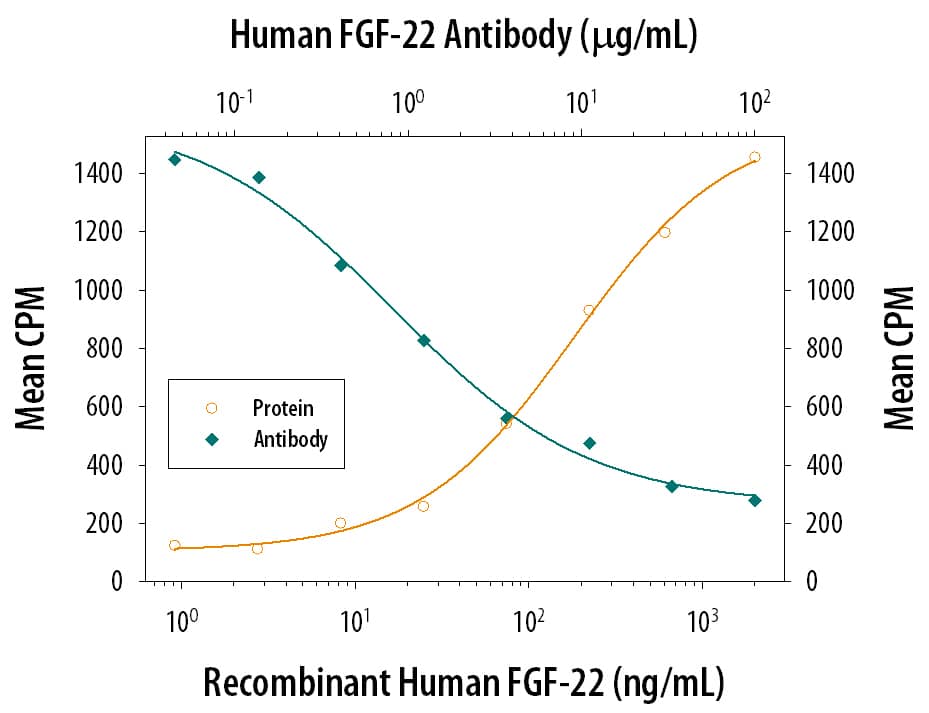FGF-22 Products
Fibroblast growth factor-22 (FGF-22) is a 23 kDa, nonglycosylated member of the FGF-7 subfamily, FGF family of heparin-binding growth factors. The human FGF-22 precursor is 170 amino acids (aa) in length, and contains a 22 aa signal sequence with a 148 aa mature region.
FGF-22 is synthesized by at least three cell types; keratinocytes, neurons, and skeletal muscle myotubes. In neurons and myotubes, FGF-22 is presumed to function as an organizer of the presynaptic apparatus. Expressed by postsynaptic (or target) cells, FGF-22 is believed to bind to FGF R2b on the surface of innervating processes, resulting in synaptic vesicle clustering, organization, and neurite branching. Although FGF-22 is assumed to be secreted, little can be found in expressing cell culture media. It thought to be bound to 34 kDa FGF-BP1, which is a molecule described as typically associated with cell membrane proteoglycans. Thus, following secretion, FGF-22 could quickly be immobilized by FGF-BP1, only to be released at a later time, or aided by FGF-BP1 in its interaction with FGF R2b.
31 results for "FGF-22" in Products
31 results for "FGF-22" in Products
FGF-22 Products
Fibroblast growth factor-22 (FGF-22) is a 23 kDa, nonglycosylated member of the FGF-7 subfamily, FGF family of heparin-binding growth factors. The human FGF-22 precursor is 170 amino acids (aa) in length, and contains a 22 aa signal sequence with a 148 aa mature region.
FGF-22 is synthesized by at least three cell types; keratinocytes, neurons, and skeletal muscle myotubes. In neurons and myotubes, FGF-22 is presumed to function as an organizer of the presynaptic apparatus. Expressed by postsynaptic (or target) cells, FGF-22 is believed to bind to FGF R2b on the surface of innervating processes, resulting in synaptic vesicle clustering, organization, and neurite branching. Although FGF-22 is assumed to be secreted, little can be found in expressing cell culture media. It thought to be bound to 34 kDa FGF-BP1, which is a molecule described as typically associated with cell membrane proteoglycans. Thus, following secretion, FGF-22 could quickly be immobilized by FGF-BP1, only to be released at a later time, or aided by FGF-BP1 in its interaction with FGF R2b.
| Source: | E. coli |
| Accession #: | Q9HCT0 |
| Applications: | BA |
| Reactivity: | Human |
| Details: | Mouse IgG2a Monoclonal Clone #435008 |
| Applications: | WB, Neut |
| Reactivity: | Human |
| Details: | Sheep IgG Polyclonal |
| Applications: | WB |
| Reactivity: | Human |
| Details: | Sheep IgG Polyclonal |
| Applications: | WB |
| Reactivity: | Human |
| Details: | Rabbit Polyclonal |
| Applications: | IHC, WB, ICC/IF |
| Reactivity: | Human |
| Details: | Mouse IgG2 Monoclonal Clone #MM0286-4F28 |
| Applications: | WB, B/N |
| Reactivity: | Human |
| Details: | Mouse IgG2 Monoclonal Clone #MM0286-4F28 |
| Applications: | WB, B/N |
| Reactivity: | Human |
| Details: | Mouse IgG2 Monoclonal Clone #MM0286-4F28 |
| Applications: | WB, B/N |
| Reactivity: | Human |
| Details: | Mouse IgG2 Monoclonal Clone #MM0286-4F28 |
| Applications: | WB, B/N |
| Reactivity: | Human |
| Details: | Mouse IgG2 Monoclonal Clone #MM0286-4F28 |
| Applications: | WB, B/N |
| Reactivity: | Human |
| Details: | Mouse IgG2 Monoclonal Clone #MM0286-4F28 |
| Applications: | WB, B/N |
| Reactivity: | Human |
| Details: | Mouse IgG2 Monoclonal Clone #MM0286-4F28 |
| Applications: | WB, B/N |
| Reactivity: | Human |
| Details: | Mouse IgG2 Monoclonal Clone #MM0286-4F28 |
| Applications: | WB, B/N |
| Reactivity: | Human |
| Details: | Mouse IgG2 Monoclonal Clone #MM0286-4F28 |
| Applications: | WB, B/N |
| Reactivity: | Human |
| Details: | Mouse IgG2 Monoclonal Clone #MM0286-4F28 |
| Applications: | WB, B/N |
| Reactivity: | Human |
| Details: | Mouse IgG2 Monoclonal Clone #MM0286-4F28 |
| Applications: | WB, B/N |
| Reactivity: | Human |
| Details: | Mouse IgG2 Monoclonal Clone #MM0286-4F28 |
| Applications: | WB, B/N |
| Reactivity: | Human |
| Details: | Mouse IgG2 Monoclonal Clone #MM0286-4F28 |
| Applications: | WB, B/N |
| Reactivity: | Human |
| Details: | Mouse IgG2 Monoclonal Clone #MM0286-4F28 |
| Applications: | WB, B/N |
| Reactivity: | Human |
| Details: | Mouse IgG2 Monoclonal Clone #MM0286-4F28 |
| Applications: | WB, B/N |
| Reactivity: | Human |
| Details: | Mouse IgG2 Monoclonal Clone #MM0286-4F28 |
| Applications: | WB, B/N |
| Reactivity: | Human |
| Details: | Mouse IgG2 Monoclonal Clone #MM0286-4F28 |
| Applications: | WB, B/N |
| Reactivity: | Human |
| Details: | Mouse IgG2 Monoclonal Clone #MM0286-4F28 |
| Applications: | WB, B/N |
| Reactivity: | Human |
| Details: | Mouse IgG2 Monoclonal Clone #MM0286-4F28 |
| Applications: | WB, B/N |
| Reactivity: | Human |
| Details: | Mouse IgG2 Monoclonal Clone #MM0286-4F28 |
| Applications: | WB, B/N |




![Western Blot: FGF-22 Antibody [NBP3-41379] - FGF-22 Antibody](https://resources.bio-techne.com/images/products/nbp3-41379_rabbit-fgf-22-pab-6122024212785.jpg)
